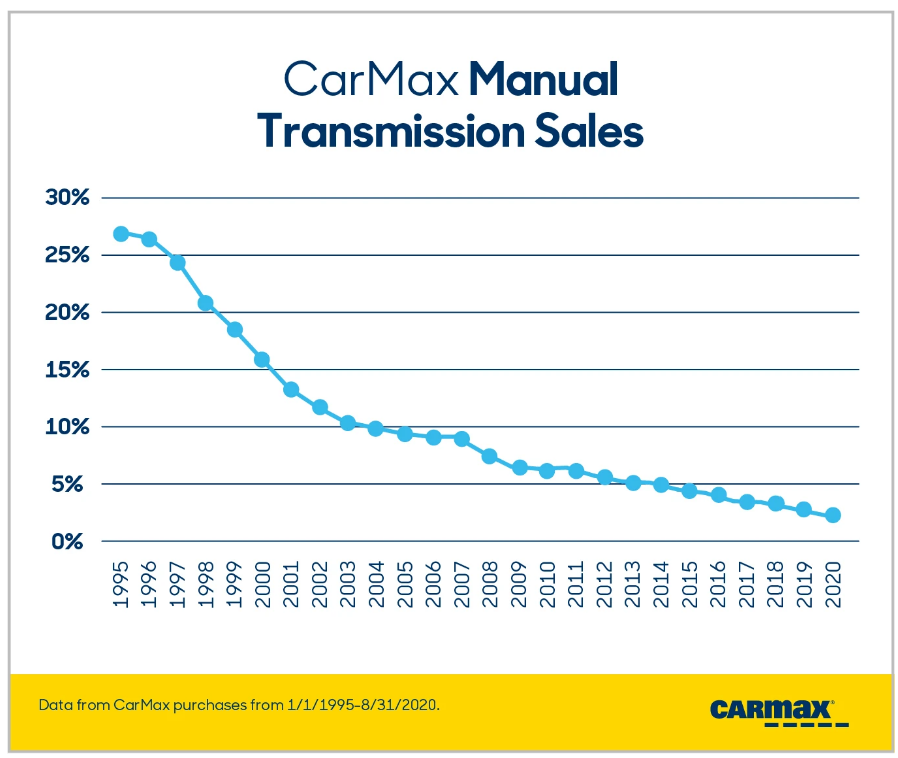What’s a sure-fire way to spot an American traveling abroad? Find the nearest rental car location and scan the customers’ faces for a tell-tale expression of panic.
“We don’t have any automatic transmission cars available.” Cue the cold sweat.
In Europe and Asia, over 80% of cars sold have manual transmission. In the United States, that number is only about 2.4%, according to 2020 data from CarMax (see Figure below). The popularity of stick shift vehicles among Americans has declined dramatically over the last three decades, a trend which doesn’t appear likely to stop any time soon. There’s no question that automatics make driving easier, but how do they stack up to manuals on safety?
Figure: Manual transmission sales as a percentage of total cars sold, 1995-2020. Source: CarMax.
Though many believe automatic cars to be safer than manuals, both transmission types each have their own advantages when it comes to safety. Automatic vehicles allow drivers to keep both hands on the wheel at all times, as well as to react more quickly and maneuver more effectively in stop-and-go traffic. Manual vehicles, on the other hand, allow for greater control; they also call for more mental engagement with driving and require the use of both hands, thus limiting the likelihood of – and opportunity for – distracted driving. The general industry consensus is that neither transmission type has an overall safety edge over the other, but research comparing the two suggests that the question may require a more nuanced look.
Who’s in the driver’s seat?
Depending on the population under investigation, certain safety advantages can carry different weights – or even become safety liabilities. Consider, for instance, a 2012 study comparing driving errors by elderly (average age 75.2 years) and middle-aged drivers (average age 39.2 years) in manual and automatic vehicles. The study found elderly drivers made nearly 60% fewer errors related to speed, maneuvering, positioning, and adherence to traffic rules when driving automatic versus manual cars (p<0.001), whereas no difference was observed between transmission types in the middle-aged group. The authors explained the results by pointing out that the additional manual tasks and concentration required for driving a stick shift could themselves constitute a significant source of distraction for elderly drivers, drawing their attention away from speed limits and other traffic laws.
In contrast, research on young drivers with attention deficit hyperactivity disorder (ADHD) has shown that manual transmission can improve attentiveness while driving and reduce driver errors, suggesting that stick shifts may be safer for those most prone to distraction while driving (teenagers, for example – drivers in their teens and early twenties have the highest reported cell phone use while driving, as well as the highest percentage of drivers involved in fatal distracted driving accidents).
Collectively, these studies underscore the idea that when it comes to comparing the safety advantages of manual and automatic cars, who will be driving matters just as much as what they’ll be driving. What compromises safety for some – for instance, the increased mental engagement required by manual transmission – can improve safety for others.
The Road Forward
As I discussed in a recent newsletter, American roads are becoming more dangerous. The incidence of traffic fatalities has skyrocketed over the last decade, a trend often attributed to distracted driving involving mobile devices. To some, the solution might be to make driving easier – to drive an automatic and have the ability to devote more attention to traffic rules and other drivers. To me, the uptick in traffic accidents is all the more reason to have more control over my car and feel deeply mentally engaged while driving – in other words, to drive a stick. (And when it comes time in a few years for my daughter to learn to drive, you can bet she’ll be doing so on my three-pedal Tacoma.) Neither solution is objectively correct; it all depends on who’s in the driver’s seat.
But whether in an automatic or a manual, the fact is that humans are fallible, and as long as we’re the ones making the countless moment-to-moment decisions we face while driving, we’ll always have occasional distractions, missed speed limit changes, forgotten blind spots, and the accidents that follow them. Someday, when self-driving cars have removed human thought from the equation, the safety debate between manual and automatic transmissions will finally be over. Until then, I, for one, want as much of my mental power on driving as possible whenever I’m on the road.





